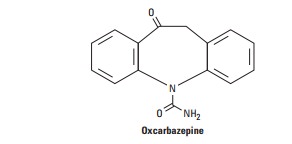Chapter: Basic & Clinical Pharmacology : Antiseizure Drugs
Oxcarbazepine
OXCARBAZEPINE
Oxcarbazepine
is closely related to carbamazepine and is useful in the same seizure types,
but it may have an improved toxicity pro-file. Oxcarbazepine has a half-life of
only 1–2 hours. Its activity, therefore, resides almost exclusively in the
10-hydroxy metabolite (especially the S(+)
enantiomer, eslicarbazepine), to which it is rapidly converted and which has a
half-life similar to that of car-bamazepine, ie, 8–12 hours. The drug is mostly
excreted as the glucuronide of the 10-hydroxy metabolite.

Oxcarbazepine
is less potent than carbamazepine, both in ani-mal models of epilepsy and in
epileptic patients; clinical doses of oxcarbazepine may need to be 50% higher
than those of carbam-azepine to obtain equivalent seizure control. Some studies
report fewer hypersensitivity reactions to oxcarbazepine, and cross-reac-tivity
with carbamazepine does not always occur. Furthermore, the drug appears to
induce hepatic enzymes to a lesser extent than carbamazepine, minimizing drug
interactions. Although hypona-tremia may occur more commonly with oxcarbazepine
than with carbamazepine, most adverse effects that occur with oxcarbazepine are
similar in character to reactions reported with carbamazepine.
Related Topics